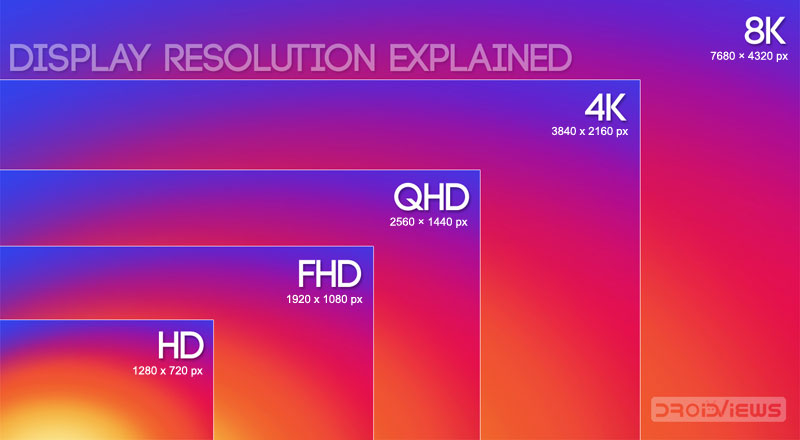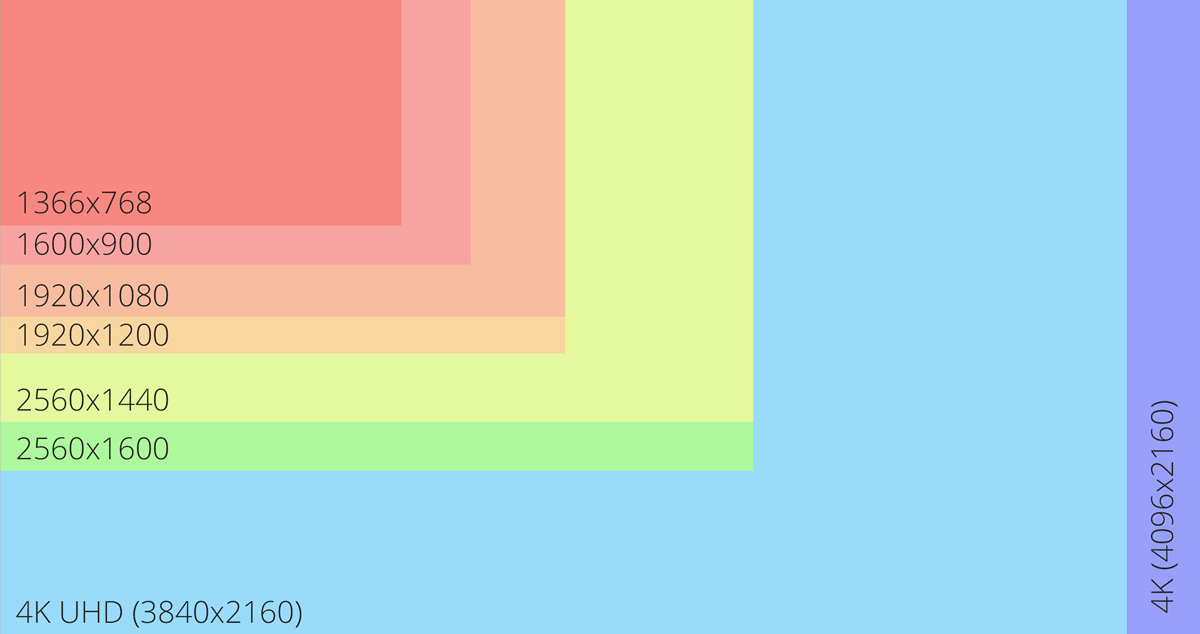
You hear these terms a lot these days regarding anything that has a digital display. From 6-inch smartphones to 55-inch (or even bigger) TV screens, these terms and random numbers are everywhere. But what do they really mean? What are 2K and 4K? Is there any difference between qHD and QHD? Is 1080p 1K? If you’re a consumer looking for a new TV, you’d be forgiven for being confused. This is even true when you buy laptops or PC monitors. We thought we’d help clear up this confusion related to screen resolution sizes and explain what exactly is the difference between qHD and QHD, HD and Full HD, and what is 1K, 2K, 4K, 5K, and 8K.
Before you proceed, I’ll recommend you to read our detailed analysis and explanation of all aspects of smartphone display technology.
What is Screen Resolution?
Resolution, to define simply, is the number of pixels on a display or screen. A single pixel, or a discrete picture element, is but one tiny dot on the screen. There are often millions of these dots that make up the full picture on your device’s display. Even a small 5-inch phone with a 720p display packs in about a million pixels. As a general rule, the more the merrier but that does not guarantee a higher resolution display will look better than another with a lower resolution. Resolution is simply one of the many factors that combine together to create a beautiful display. It alone can’t be the deciding factor between a good and a bad display.
Other factors such as Dynamic range, color reproduction, are also very important. However, screen resolution is perhaps one of the most important specifications of a display, especially when you’re buying something bigger than a smartphone. Let’s see what is the difference between different screen resolution sizes.
But before we start learning screen resolutions, let’s find out what is the difference between screen resolution and screen size and why screen resolution is so important.
Screen Resolution and Screen Size
When it comes to screens, bigger isn’t always better. In fact, there’s a lot more to consider than just the size of the screen. Screen resolution is a major factor in determining picture quality, and it’s important to know the difference between the two before making a purchase.
Screen size is simply the physical dimensions of the display. The most common measurement for screens is diagonal width, which is expressed in inches. For example, a 24-inch monitor has a screen that measures 24 inches from corner to corner.
Screen resolution, on the other hand, refers to the number of pixels that make up the image on the screen. The higher the resolution, the more pixels there are and the sharper the image will be. A resolution of 1920×1080, for example, has a total of 2.07 million pixels.
While screen size is a matter of personal preference, resolution is a more important consideration when it comes to picture quality.
Why Screen Resolution is Important?
Screen resolution is important because it affects how much information you can see on your screen at once. The higher the resolution, the more information you can see. This is especially important for people who work with graphics or need to be able to see a lot of information at once, like programmers or data analysts.
In addition, screen resolution can affect how well you can see text and images on your screen. If the resolution is too low, text and images may be fuzzy or hard to read. This can be frustrating and make it difficult to do your work.
That’s why it’s important to choose a screen resolution that works best for you and your needs.
HD/720p and Full HD/1080p
HD is probably the most used and misused marketing term you have ever heard of before. It’s thrown around attached to all kinds of words, Full HD, Ultra HD, Quad HD, etc. Right now, let’s focus on what HD means. As most of you already do, it means high definition. The term has become identical with anything that raises the detail or quality over-and-above something that came before. You may even see companies use it in other areas like Sony, that sells audio equipment with HD audio support.
In terms of displays, HD refers to the resolution of the original HD TVs that first came around. There were a few, but the most basic was 1280 x 720 pixels, or more commonly called 720p. The ‘p’ is for progressive can as opposed to 720i, where the ‘i’ stands for interlaced. The difference between the ‘p’ and ‘i’ is a whole different topic so we won’t go over it here. These days though, especially when it comes to TVs, HD is not so HD anymore.
Full HD is the real HD, and displays with this resolution pack in about 2 million pixels. That’s twice as much as HD. Full HD measures at measures 1,920 x 1,080 pixels, often referred to as 1080p. Most basic TVs today are 1080p and that’s true for a huge number of smartphones as well.
qHD, QuadHD/WQHD/1440p, and 2K Resolutions
qHD, and QHD, while spelled pretty much the same couldn’t be any more different. qHD stands for a quarter of full HD, ie, four times less than 1080p. The typical qHD resolution is 960 x 540 pixels or 540p. QHD, on the other hand, is four times the standard HD resolution. Keep in mind, four times the HD resolution, not Full HD. The typical QHD resolution is 2,560 x 1,440 pixels or 1440p. That’s four times as many pixels as 1280 x 720 or 720p.
If you’re counting, Quad HD or QHD contains 4 million pixels. As is the case with all HD derived resolutions, QHD also has an aspect ratio of 16:9 which is considered wide. For this reason, some manufacturers like to put a W in front, marketing it as WQHD. The W is there to explicitly state a wide aspect ratio, although it is essentially the same thing as QHD.
QHD displays are very common in Android flagship smartphones these days. QHD is also often referred to as 2K because it is half of 4K. But mostly, 2K refers to a resolution where the larger of the pixel measurements is over 2000 pixels. The typical 2K resolution is 2,048 × 1,080 pixels. So it’s basically a 1080p display but with a much wider aspect ratio. 2K is therefore not quite the same as QHD, and in fact, QHD is better.
Don’t Miss: PPI vs DPI: What are They & What’s the Difference?
4K and UHD Resolutions
Many of you may think 4K and UHD are one and the same and it isn’t your fault. Companies often use these interchangeably and together. Pick up any Blu-Ray Cover for 4K movie and it will most definitely also have the Ultra HD label. 4K is actually not a consumer display and broadcast standard, unlike UHD which is. 4K displays are used in professional production and digital cinemas and feature 4,096 x 2,160 pixels. That’s a wider aspect ratio than 16:9, much like 2K.
UHD, on the other hand, features a 16:9 aspect ratio and is four times the resolution of full HD. In other words, four times 1080p, four times 1920 x 1080 pixels, that is 3,840 x 2,160 pixels. Having the same 16:9 aspect ratio means it is backward compatible with other HD derivatives. However, both 4K and UHD can be shortened to 2160p to match the HD standard and therefore, companies use the terms interchangeably.
5K Resolution
5K describes a display resolution of 5120 x 2880 and it is mostly found in Apple’s 27-inch iMac display. LG’s 27-inch Ultrafine 5K monitor also outputs at 5120 x 2880. Outside of these, the 5K resolution is not all that common.
8K and 8K UHD Resolutions
All digital displays or images with a width or higher pixel value of approximately 8000 pixels have an 8K resolution. 8K resolution produces vivid colors and details. It’s said that at this level of resolution the human eyes cannot notice the pixels and the displayed images look very clear as no dots are visible to the eyes. As for 8K UHD resolution displays, they have an aspect ratio of 16:9 and have around 7680 × 4320 pixels.
Screen Resolution Sizes
The table below may help you understand screen resolution sizes better.
| Resolution name | Horizontal x vertical pixels | Other names | Devices |
|---|---|---|---|
| 8K | 7680 x 4320px | 8K UHD | TVs |
| 4K Cinema | 4096x [unspecified] | 4K | projectors |
| UHD | 3840 x 2160px | 4K, Ultra HD, Ultra High Definition | TVs, monitors, smartphones |
| 2K | 2048x [unspecified] | none | projectors |
| WUXGA | 1920 x 1200px | Widescreen Ultra Extended Graphics Array | monitors, projectors |
| 1080p | 1920 x 1080px | Full HD, FHD, HD, High Definition | TVs, monitors, smartphones |
| 720p | 1280 x 720px | HD, High Definition | TVs, Smartphones |
We also have this image to help you if you need more help.

What TV Should You Buy in 2022
4K TVs are becoming increasingly popular, as more and more content is being produced in 4K resolution. Many major streaming services, such as Netflix, Amazon Prime Video, and Hulu, now offer 4K content. There are also a number of dedicated 4K channels available on cable and satellite TV.
If you’re looking to buy a new TV, it’s important to make sure that it has 4K capabilities. Most newer TVs on the market these days are 4K-compatible, but it’s always worth double-checking before making your purchase. 4K resolution offers the best possible viewing experience, so if you can afford it, it’s definitely worth investing in a 4K TV.
Later in 2022 even 8K TVs will start to become more common. This means that your favorite shows and movies will look even better than they do now. But it’s not just about the resolution. The color, contrast, and detail will all be improved, making for a more immersive viewing experience. So if you’re looking to upgrade your TV in the near future, be sure to keep an eye out for the latest and greatest TVs. They’ll be worth the investment.
Smartphone Resolutions: What Will be Common Later in 2022?
By second half of 2022, smartphone resolutions will be much higher than they are today. We can expect to see resolutions of at least 4K, and possibly even 8K. This will make for a much more immersive experience when using smartphones for gaming, watching videos, or simply browsing the web.
It’s also likely that we’ll see wider use of 3D displays in smartphones by that time. This will add an extra level of realism to games and other multimedia content. Additionally, it could pave the way for new types of augmented reality experiences.
All in all, 2022 is looking to be a very exciting year for smartphone users! We can’t wait to see what the next generation of devices has in store for us.

